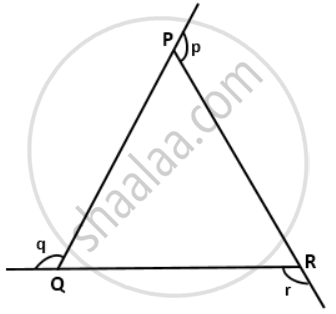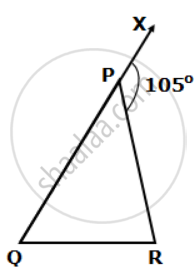Advertisements
Advertisements
Question
Use the given figure to show that: ∠p + ∠q + ∠r = 360°.
Solution
By exterior angle property,
∠p = ∠PQR + ∠PRQ
∠q = ∠QPR + ∠PRQ
∠r = ∠PQr + ∠QPR
Now, ∠p + ∠q + ∠r
= ∠PQR + ∠PRQ + ∠QPR + ∠PRQ + ∠PQR + ∠QPR
⇒ ∠p + ∠q + ∠r = 2∠PQR + ∠2PRQ + 2∠QPR
⇒ ∠p + ∠q + ∠r = 2(∠PQR + ∠2PRQ + 2∠QPR)
⇒ ∠p + ∠q + ∠r = 2 x 180° ....[Angle sum property: ∠PQR + ∠PRQ + ∠QPR = 180°]
⇒ ∠p + ∠q + ∠r = 360°.
APPEARS IN
RELATED QUESTIONS
In the given figure, ∠Q: ∠R = 1: 2. Find:
a. ∠Q
b. ∠R
The exterior angles, obtained on producing the side of a triangle both ways, are 100° and 120°. Find all the angles of the triangle.
In a triangle PQR, ∠P + ∠Q = 130° and ∠P + ∠R = 120°. Calculate each angle of the triangle.
The angles of a triangle are (x + 10)°, (x + 30)° and (x - 10)°. Find the value of 'x'. Also, find the measure of each angle of the triangle.
In a triangle ABC. If D is a point on BC such that ∠CAD = ∠B, then prove that: ∠ADC = ∠BAC.
In a triangle ABC, if the bisectors of angles ABC and ACB meet at M then prove that: ∠BMC = 90° + `(1)/(2)` ∠A.
If each angle of a triangle is less than the sum of the other two angles of it; prove that the triangle is acute-angled.
If the angles of a triangle are in the ratio 2: 4: 6; show that the triangle is a right-angled triangle.
In a triangle, the sum of two angles is 139° and their difference is 5°; find each angle of the triangle.
In a right-angled triangle ABC, ∠B = 90°. If BA and BC produced to the points P and Q respectively, find the value of ∠PAC + ∠QCA.
